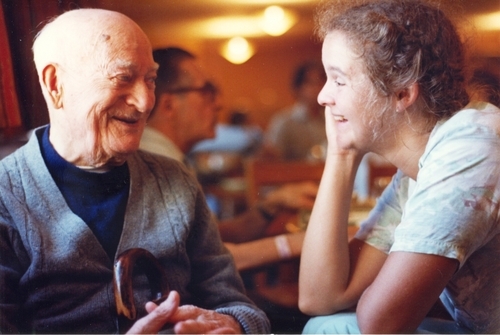Hoyt, Alfred Geoffrey: my Army and Air Force recollections (June 10, 1985)
ABSTRACT: Col. Alfred Geoffrey Hoyt The Canadian Scottish Regiment Royal Canadian Air Force Hoyt_A_0083_01.mp3 (Side 1) Born in 1921 at San Bernardino, Calif. of Canadian parents. Family returned to Nanaimo in 1929. At the age of fifteen he joined the 2nd Battalion, Canadian Scottish Regiment (militia) and two years later, in 1939, was mobilized. Discusses conditions and attitudes toward the military in Nanaimo. Was sent to Prince Rupert to guard the harbour. Much training of recruits. Because of his age he did not go overseas with the unit. Remustered into the air force as air crew in order to get overseas. manning depot and initial training school in Edmonton. Unsuccessful in pilot training, so opted for navigation training at Portage la Prairie. Was awarded wings and commissioned. (30:00) Overseas from Halifax in Jan. 1943. Conditions in England. Kept busy until the "air crew pipeline" required him. Many navigational courses, including visual navigation in England which was the most difficult. Converted to the Handley Page Halifax. Flew to Italy via North Africa. The only Canadian and only officer in the crew. (45:00) Comments on various bomber aircraft. Joined No. 614 Squadron, R.A.F. which was a Pathfinder squadron. Very accurate navigation was required so that the target could be identified at night by the bomber force. Flew for almost a year from Foggia Plain in Italy. On operations the squadron usually put up eight aircraft, three or four carrying illuminating flares, three with visual target markers, and a "Master Bomber". The latter adjusted the fall of visual markers if necessary and the approach of bombers onto the target. His fifth operational flight was to the Ploiesti, Rumanian oilfields, carrying illuminating flares. The oilfields were heavily defended for miles around. As the first aircraft on the target they were held in searchlight cones for a total of fourteen minutes, were heavily damaged, but managed to return to Italy, although their aircraft was deemed to be a write-off. Half of the squadron was lost on this mission; about twenty per cent was the usual casualty rate. Finished first tour of forty operations and made ten more before the war ended. Later on they converted to Consolidated Liberators (20:00) as the American spare parts were much more easily available than were those for the Halifax. As a flight lieutenant he became senior navigator for the squadron. The LORAN navigation system came in at this time (40:00). Usual targets were enemy airfields, bridges, railyards, etc. in Italy and the Balkans. Toward the end of the war they ferried supplies to Tito's partisans and ammunition to Athens, Greece. Was removed from the squadron and sent home to Canada soon after the war in Europe ended. (48:00) Hoyt_A_0083_02.mp3 (Side 2) Graduated in civil engineering from the University of British Columbia in 1950. Rejoined the R.C.A.F. as an engineer officer. Wartime seniority helped him regain the rank of flight lieutenant in a few months. Much new construction as well as repair of "temporary" wartime buildings. North West Air Command, Edmonton. Base construction engineer at Trenton, Ont. Similar positions and more senior ones in western Canada. Integration in the 1960s was a good idea for the support services, but a different story for the operational elements. Was posted to Europe where much construction negotiation took place with N.A.T.O. partners regarding costs, changes in construction requirements, etc. (15:00) Offers impressions of various nationalities. Personally very busy during a tough time for the Canadian forces as a whole. Was appointed to mobile command in Montreal. Director general of works at D.N.D. in Ottawa. Much involvement in maintenance and environmental problems. Retired in 1975. Worked for the B.C. Dept. of Forestry. Was involved with the Military Engineers Association. (45:00)
Interviewee: Hoyt, Alfred Geoffrey, 1921-1998
Interviewer: Hill, Mark C.
Rank: Colonel.
An interview/narrative of Alfred Geoffrey Hoyt's experiences during World War II. Colonel Hoyt served with the Canadian Scottish Regiment and the Royal Canadian Air Force. Interview took place on June 10, 1985.
- In Collection:
- 2 sound recordings (MP3)
- 45.50884, -73.58781
- 52.16045, -0.70312
- One original sound tape reel (ca. 135 min.) : 1 7/8 ips, track, mono. ; 2 sound cassette copies : standard, mono. in Special Collections.
- Canadian Military Oral History Collection
- HAG_083
- Special Collections Finding Aid: https://search.archives.uvic.ca/reginald-herbert-roy-fonds
- June 14, 2007
- Digital sound recording in .wav format at 16 bits and 22 kHz. In .mp3 format at 64 kbps and 22 kHz. Digitized by AN, technical and cataloguing metadata provided by JF and JP. Transferred from audio reel to audio cassette between 1987-1997. Interview migrated to digital format for UVic Special Collections in 2007. Migration metadata by KD and MT.
- Rights
- This interview has been posted with the understanding that it may be used for research purposes only. Should the interviewee or their heirs have any objections to this interview being accessible on the Internet, it will be removed promptly. Contact UVic Special Collections for permission if using for other than research purposes: speccoll@uvic.ca
- DOI
| Thumbnail | Title | Date Uploaded | Actions |
|---|---|---|---|
|
|
SC141_MilitaryOralHistory_GenericThumbnail |
|
|

|
Hoyt_A_0083_01.mp3 |
|
|

|
Hoyt_A_0083_02.mp3 |
|